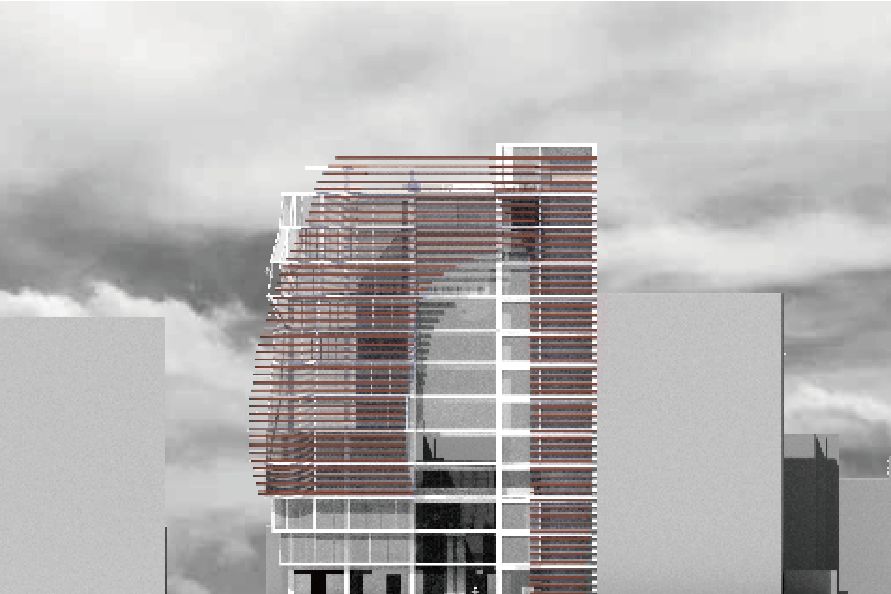

Chasing Pavement
Instructor: Ih-Cheng Lai
Site: Greenland
This project adopts a bionic design approach, where a specific creature is studied and an Arduino-based movable device is designed.
The study focuses on the unique Australian animal known as the Thorny Devil, which inhabits the arid regions of inland Australia. One notable feature of this creature is its ability to absorb water through its skin, enabling it to survive in such a dry environment. The primary objective of this study is to investigate the efficient mechanisms employed by the Thorny Devil to moisturize and transport water. To achieve this, the chosen site for the project is Greenland, which is located near the polar region. The rationale behind this choice is to explore the development of a self-sustaining system within a resource-limited environment.

Thorny Devil
The Thorny Devil, also known as Thorny Dragon or Moloch, is a species of lizard that inhabits the inland deserts of Australia.
The Thorny Devil typically reaches a total length of up to 21 cm (8.3 in) and has an average lifespan of 15 to 20 years.
Its body is covered in hard and sharp spines, serving as a defense mechanism against predators, making it difficult to be swallowed.
A notable feature of the Thorny Devil is the presence of a spiny "false head" located on the back of its neck, which serves as a protective adaptation against enemies. The "false head" is composed of soft tissue. Moreover, the Thorny Devil's skin possesses the unique ability to conduct water throughout its body, ultimately leading it to the mouth.
Arduino UNO
Arduino is an open-source electronics platform that utilizes user-friendly hardware and software. It enables Arduino boards to interpret inputs, such as light detected by a sensor or a button press, and translate them into corresponding outputs, such as activating a motor or illuminating an LED. Additionally, Arduino allows for online publishing of data or information.
One of the widely used Arduino boards is the Arduino Uno, which is an open-source microcontroller board built around the Microchip ATmega328P microcontroller.
The Thorny Devil, also known as Thorny Dragon or Moloch, is a species of lizard that inhabits the inland deserts of Australia.
The Thorny Devil typically reaches a total length of up to 21 cm (8.3 in) and has an average lifespan of 15 to 20 years.
Its body is covered in hard and sharp spines, serving as a defense mechanism against predators, making it difficult to be swallowed.
A notable feature of the Thorny Devil is the presence of a spiny "false head" located on the back of its neck, which serves as a protective adaptation against enemies. The "false head" is composed of soft tissue. Moreover, the Thorny Devil's skin possesses the unique ability to conduct water throughout its body, ultimately leading it to the mouth.
Arduino UNO
Arduino is an open-source electronics platform that utilizes user-friendly hardware and software. It enables Arduino boards to interpret inputs, such as light detected by a sensor or a button press, and translate them into corresponding outputs, such as activating a motor or illuminating an LED. Additionally, Arduino allows for online publishing of data or information.
One of the widely used Arduino boards is the Arduino Uno, which is an open-source microcontroller board built around the Microchip ATmega328P microcontroller.
Site
Greenland, home to the second-largest ice sheet in the world, is profoundly impacted by global warming. I have chosen this location as the site for my study due to its limited access to water, resembling the challenging conditions faced by the thorny devil in the desert. My objective is to apply the water absorption principle observed in lizards to this context.
The residents of Greenland primarily inhabit low-lying areas, and the fishing industry plays a crucial role in the local economy. However, the effects of global warming have significantly impacted Greenland's environment, housing, lifestyle, and industry. The temperature in Northern Europe is influenced by the North Atlantic warm current, which is believed to be an extension of the Gulf Stream. The melting of the ice sheet in Greenland's mountains results in the flow of melting ice into the ocean, disrupting the North Atlantic warm current.
The melting ice layers also release ancient Methane deposits from under the sea, leading to a further increase in temperature and creating a self-perpetuating cycle. Additionally, the thawing of permafrost contributes to the degradation of house foundations and infrastructure.



Strategy
The entire mechanism is divided into three layers. The upper layer serves as the shelter, while the lower layer functions as the water conduction network. When sunlight reaches the ground, the light sensor activates and opens the shelter. Simultaneously, the mechanism facilitates the conduction of water to the designated area. The middle layer is designed as a living space for individuals and also accommodates the mechanical devices.

Firefly
In order to simulate real-time transformations, I utilize the Grasshopper plug-in FIREFLY and establish a connection with Arduino UNO. This allows me to visually display the dynamic changes of the mechanism as it transitions between states of sensitization and deformation.
In order to simulate real-time transformations, I utilize the Grasshopper plug-in FIREFLY and establish a connection with Arduino UNO. This allows me to visually display the dynamic changes of the mechanism as it transitions between states of sensitization and deformation.




Site model
Interactive models












